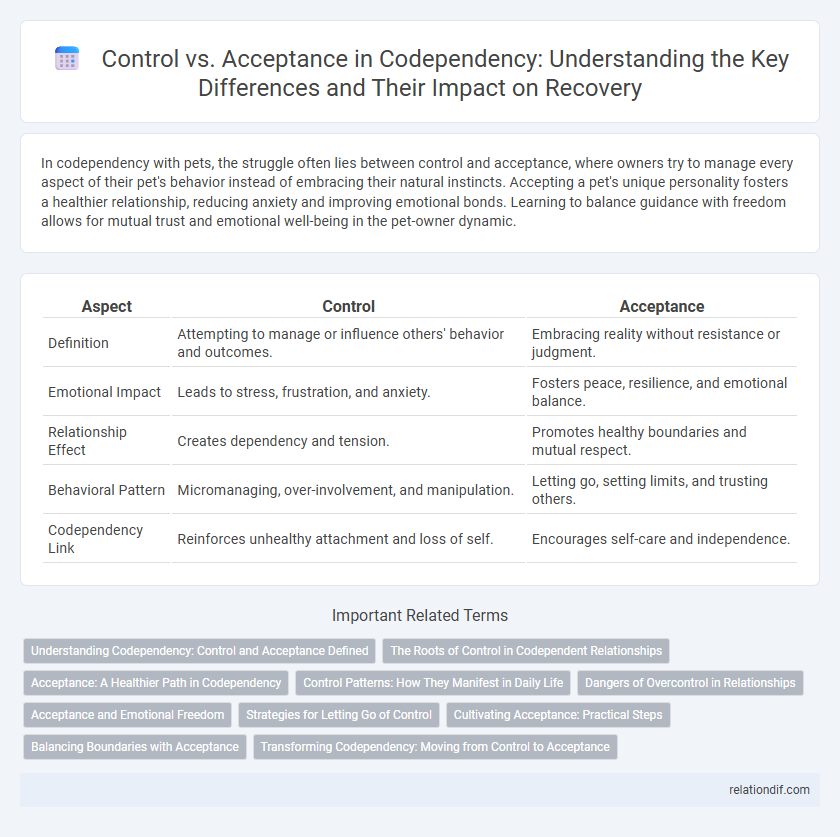In codependency with pets, the struggle often lies between control and acceptance, where owners try to manage every aspect of their pet's behavior instead of embracing their natural instincts. Accepting a pet's unique personality fosters a healthier relationship, reducing anxiety and improving emotional bonds. Learning to balance guidance with freedom allows for mutual trust and emotional well-being in the pet-owner dynamic.
Table of Comparison
| Aspect | Control | Acceptance |
|---|---|---|
| Definition | Attempting to manage or influence others' behavior and outcomes. | Embracing reality without resistance or judgment. |
| Emotional Impact | Leads to stress, frustration, and anxiety. | Fosters peace, resilience, and emotional balance. |
| Relationship Effect | Creates dependency and tension. | Promotes healthy boundaries and mutual respect. |
| Behavioral Pattern | Micromanaging, over-involvement, and manipulation. | Letting go, setting limits, and trusting others. |
| Codependency Link | Reinforces unhealthy attachment and loss of self. | Encourages self-care and independence. |
Understanding Codependency: Control and Acceptance Defined
Codependency involves a complex dynamic where control manifests as a compulsive need to influence others' behaviors to maintain stability or self-worth, often leading to unhealthy boundaries. Acceptance in codependency signifies embracing reality and others' autonomy without attempting to change or fix them, fostering emotional resilience and healthier relationships. Understanding these opposing forces helps individuals recognize patterns in codependent relationships and cultivate balanced interactions rooted in mutual respect and self-awareness.
The Roots of Control in Codependent Relationships
The roots of control in codependent relationships often stem from deep-seated fears of abandonment and low self-worth, leading individuals to manipulate situations to maintain a sense of stability and security. These control behaviors mask underlying anxiety and a need for validation, preventing genuine acceptance of partners as autonomous beings. Understanding this dynamic is crucial for breaking the cycle of control and fostering healthier, more balanced interpersonal connections.
Acceptance: A Healthier Path in Codependency
Acceptance in codependency fosters emotional healing by encouraging individuals to acknowledge their limitations and relinquish the need to control others' behaviors. Embracing acceptance reduces anxiety and promotes healthier boundary-setting, enabling personal growth and genuine connections. Research indicates that acceptance-based approaches enhance resilience and facilitate recovery from codependent patterns more effectively than control-driven strategies.
Control Patterns: How They Manifest in Daily Life
Control patterns in codependency often manifest through excessive micromanaging of others' behaviors and decisions, driven by a fear of uncertainty or loss. Individuals may create rigid routines and impose strict rules to manage their environment, seeking validation through predictability. This relentless need for control undermines emotional well-being and inhibits authentic relationships by prioritizing dominance over genuine acceptance.
Dangers of Overcontrol in Relationships
Excessive control in relationships often breeds resentment and stifles emotional growth, leading to imbalance and weakened intimacy. Overcontrol can trigger anxiety and erode trust, causing partners to feel suffocated and disconnected. Recognizing the dangers of control and fostering acceptance promotes healthier boundaries and mutual respect essential for lasting connections.
Acceptance and Emotional Freedom
Acceptance in codependency fosters emotional freedom by encouraging individuals to acknowledge their feelings without judgment, reducing the need to control others or outcomes. Embracing acceptance helps break the cycle of dependency, allowing for healthier boundaries and authentic self-expression. This emotional liberation supports personal growth and resilience, creating a foundation for balanced relationships.
Strategies for Letting Go of Control
Effective strategies for letting go of control in codependency involve setting clear personal boundaries and practicing mindfulness to stay present without imposing outcomes. Emphasizing acceptance cultivates emotional resilience, allowing individuals to respond to situations rather than react impulsively. Utilizing therapeutic techniques like cognitive-behavioral therapy (CBT) helps reframe control-related thoughts and fosters healthier relational dynamics.
Cultivating Acceptance: Practical Steps
Cultivating acceptance in codependency involves recognizing personal limits and embracing the reality of situations beyond control. Practicing mindfulness and self-compassion aids in reducing the urge to control others, fostering healthier emotional boundaries. Engaging in therapy or support groups can provide essential tools and community encouragement to shift from control-driven behaviors to acceptance-based coping strategies.
Balancing Boundaries with Acceptance
Balancing boundaries with acceptance involves recognizing personal limits while embracing others' autonomy, which is crucial in overcoming codependency. Establishing clear boundaries protects emotional well-being and prevents enabling behaviors, fostering healthier relationships. This balance empowers individuals to control their responses without attempting to control others, cultivating mutual respect and emotional independence.
Transforming Codependency: Moving from Control to Acceptance
Transforming codependency involves shifting from a need to control others to embracing acceptance of their autonomy and imperfections. This process fosters healthier boundaries, emotional resilience, and mutual respect in relationships. Embracing acceptance reduces anxiety and enables growth by prioritizing personal well-being over manipulation or control.
Control vs Acceptance Infographic

 relationdif.com
relationdif.com